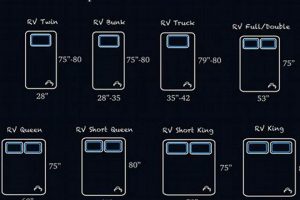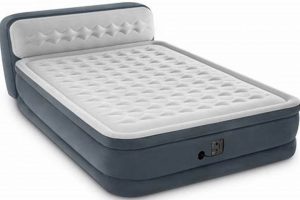A mattress measuring 60 inches wide by 80 inches long is commonly known as a Queen size mattress. This dimension offers a balance between space efficiency and sleeping area, making it a popular choice for single sleepers who desire ample room or for couples seeking a comfortable shared sleeping surface. Its dimensions provide a significant upgrade from a Full size, offering more width without the expansive footprint of a King.
The Queen size mattress occupies a strategic position in the mattress market due to its versatility. It suits a variety of bedroom sizes, from smaller apartments to moderately sized master bedrooms. The historical context of the Queen size reflects the evolving needs of consumers who desire increased personal space in their sleep environments without sacrificing the convenience of fitting into standard bedroom layouts. The proliferation of Queen size bedding and accessories further solidifies its practical advantages.
This article will delve into the suitability of this mattress size for different individuals and bedroom configurations. It will also explore the range of available mattress types and related accessories designed to complement this specific size, offering guidance for selecting the optimal sleep solution.
Tips Regarding a Queen Mattress
This section provides essential considerations for those contemplating a Queen size mattress. These tips aim to facilitate informed decisions regarding its purchase, use, and care.
Tip 1: Measure Room Dimensions: Before purchasing, accurately measure the bedroom. A Queen size mattress requires adequate space for comfortable movement around the bed. Factor in nightstands and other furniture when assessing the suitability of the room.
Tip 2: Consider Sleeper Size and Needs: A Queen size is adequate for couples who prefer closer sleeping arrangements. Larger individuals or those who prefer more personal space might consider a King size instead.
Tip 3: Evaluate Mattress Type: Queen mattresses are available in various types, including innerspring, memory foam, latex, and hybrid. Research the properties of each type to select one that best suits individual sleep preferences and needs, considering factors like support, pressure relief, and temperature regulation.
Tip 4: Check Bed Frame Compatibility: Ensure the existing or intended bed frame is specifically designed for a Queen size mattress. Using an incorrect frame can lead to inadequate support and premature mattress wear.
Tip 5: Budget for Additional Expenses: Purchasing a mattress involves more than just the mattress itself. Factor in the cost of a suitable bed frame, bedding, mattress protector, and potentially new pillows.
Tip 6: Rotate Regularly: To promote even wear and prolong the life of the mattress, rotate it 180 degrees every six months. This helps distribute weight evenly across the surface.
Tip 7: Use a Mattress Protector: A high-quality mattress protector shields the mattress from spills, stains, and allergens, thus safeguarding its warranty and maintaining hygiene.
These tips provide a foundational understanding of key considerations related to a Queen size mattress, ultimately enabling a more informed and satisfying purchase.
The subsequent sections will elaborate on the practical applications and maintenance strategies for optimal enjoyment of this specific mattress size.
1. Queen designation
The term “Queen designation” serves as the definitive label for a mattress that measures 60 inches in width and 80 inches in length. This designation is not arbitrary; it represents a standardized sizing convention recognized throughout the bedding industry, directly correlating to specific dimensions.
- Standardized Measurement
The “Queen designation” guarantees that the mattress adheres to predetermined dimensions of 60×80 inches. This standardization allows consumers to confidently purchase bedding and bed frames specifically designed for a Queen-sized mattress, ensuring compatibility and proper fit. Without this standardized designation, confusion and incompatibility would be prevalent.
- Industry Recognition
The bedding industry universally acknowledges the Queen designation. Manufacturers of mattresses, bed frames, and bedding accessories all utilize this term to denote products that are designed to work together. This uniform recognition simplifies the shopping experience for consumers, eliminating the need to rely on potentially inaccurate or inconsistent measurements.
- Market Differentiation
The Queen designation differentiates this particular mattress size from other available options, such as Full, King, and Twin. This distinction enables consumers to quickly and easily identify the appropriate mattress size based on their individual needs and space constraints. The Queen size occupies a middle ground between smaller and larger options, offering a balance of space and comfort.
- Consumer Expectations
The term “Queen designation” carries with it a set of consumer expectations regarding the overall size and suitability of the mattress. Consumers generally expect a Queen mattress to comfortably accommodate two adults, while still fitting within a reasonable bedroom footprint. This expectation influences purchasing decisions and contributes to the popularity of this particular size.
In summary, the “Queen designation” is intrinsically linked to “what size mattress is 60×80” by providing a universally understood and standardized identification. This standardization streamlines the shopping process, ensures compatibility between mattresses and accessories, and manages consumer expectations regarding size and suitability.
2. Bedroom suitability
The dimensions of a Queen size mattress, at 60×80 inches, directly impact its suitability for various bedroom sizes. Bedroom suitability, in turn, is a crucial consideration in the selection process. Overlooking this factor can result in a cramped and uncomfortable living space. The physical dimensions dictate the necessary floor space for comfortable movement around the bed and the placement of complementary furniture. A small bedroom, for instance, may become overly crowded with a Queen size mattress, impeding accessibility to other areas of the room. Conversely, in a larger bedroom, a Queen size mattress may provide an adequate sleeping surface without dominating the space.
A real-life example illustrating this principle involves individuals residing in apartments with compact bedrooms. Often, a Full-size mattress is selected over a Queen, despite a preference for the increased sleeping space, simply to maintain functionality within the limited square footage. In contrast, homeowners with larger master bedrooms frequently find that a Queen size mattress provides sufficient sleeping space while leaving ample room for dressers, nightstands, and other bedroom essentials. The understanding of this relationship allows prospective buyers to assess their spatial constraints and make informed decisions, preventing the inconvenience of an ill-fitting mattress.
In conclusion, bedroom suitability forms an integral part of the decision-making process when considering a mattress measuring 60×80 inches. Accurate assessment of room dimensions and the intended layout are critical. Ignoring this aspect can lead to practical challenges, affecting the overall functionality and aesthetic appeal of the bedroom. The correlation between mattress size and room size ensures a comfortable and functional living space, ultimately contributing to improved sleep quality and overall satisfaction.
3. Couple compatibility
Couple compatibility, in the context of a mattress measuring 60×80 inches, refers to the ability of the sleeping surface to adequately accommodate two individuals without compromising sleep quality or comfort. Mattress size plays a direct role in determining the feasibility of comfortable co-sleeping. Limited space can lead to sleep disturbances, while ample space contributes to undisturbed rest.
- Motion Isolation
Motion isolation refers to the mattress’s ability to minimize the transfer of movement from one side of the bed to the other. A mattress with poor motion isolation can cause significant sleep disruption for couples as one partner’s movements are felt by the other. Memory foam and latex mattresses typically exhibit superior motion isolation compared to traditional innerspring mattresses. Adequate motion isolation is crucial for couple compatibility on a 60×80 inch surface.
- Edge Support
Edge support dictates the stability of the mattress perimeter. Weak edge support results in a feeling of roll-off when sleeping near the edge, limiting the usable sleep surface. This becomes particularly relevant for couples sharing a smaller mattress, such as a Queen. Strong edge support maximizes the available sleeping area, providing each partner with more space. Mattresses with reinforced edges enhance couple compatibility by preventing the sensation of falling off the bed.
- Temperature Regulation
Differences in body temperature and preferences can lead to discomfort and sleep disruption. A mattress with poor temperature regulation can trap heat, causing one or both partners to overheat. Conversely, a mattress with good breathability and cooling properties promotes a more comfortable sleep environment for both individuals. Materials like latex and open-cell memory foam are known for their temperature-regulating capabilities, improving couple compatibility on a 60×80 inch surface.
- Personal Space
Even with good motion isolation, edge support and temperature regulation, the limited dimensions of the mattress may impede a comfortable sleep because of the lack of personal space. The 60 inches wide is equivalent to 30 inches per person. Consider whether that is enough room to spread out, turn over, and change positions without disturbing your partner. If more personal space is desired, a King size mattress may be more suitable.
These facets, motion isolation, edge support, temperature regulation, and personal space, demonstrate the complex interplay between mattress dimensions and couple compatibility. A 60×80 inch mattress may prove adequate for some couples but insufficient for others, depending on individual preferences, sleeping habits, and physical size. These factors need assessment to determine the optimal solution for shared sleep comfort.
4. Bedding availability
Bedding availability is directly correlated to standardized mattress dimensions. The ubiquitous presence of bedding designed for a mattress measuring 60×80 inches is a significant advantage for consumers, streamlining the purchasing process and ensuring compatibility between the mattress and its accompanying accessories.
- Widespread Retail Presence
The standardization of the 60×80 inch mattress, commonly known as a Queen size, has resulted in a comprehensive retail presence of appropriately sized bedding. Major retailers, both online and in brick-and-mortar stores, consistently stock a wide array of sheets, comforters, duvet covers, and mattress protectors specifically designed for this size. This ubiquity simplifies the shopping experience, minimizing the risk of purchasing ill-fitting or incompatible bedding. For instance, locating Queen size sheets in a department store typically requires minimal effort, compared to sourcing bedding for less common or custom mattress sizes.
- Variety of Styles and Materials
The high demand for bedding compatible with the 60×80 inch mattress has spurred manufacturers to produce a diverse range of styles and materials. Consumers can readily find options ranging from budget-friendly microfiber sheets to luxury Egyptian cotton sets, catering to various price points and preferences. This extensive selection allows for personalized customization of the sleep environment. An example is the availability of cooling sheets designed to enhance temperature regulation, or hypoallergenic bedding to address sensitivity concerns.
- Simplified Online Shopping
Online retailers have capitalized on the standardized sizing of bedding designed for mattresses measuring 60×80 inches. Product listings clearly identify items as “Queen size,” enabling consumers to confidently make purchases without the need for precise measurements or complex size conversions. Filters and search parameters allow for easy navigation and comparison of different options. For example, a consumer can filter search results on an e-commerce platform to display only Queen-size comforters within a specified price range, streamlining the selection process.
- Reduced Customization Needs
The readily available nature of bedding designed for the 60×80 inch mattress significantly reduces the need for custom-made items. Custom bedding can be expensive and time-consuming to acquire. The standardized size eliminates this requirement for most consumers, as readily available options are typically sufficient. For instance, a consumer furnishing a guest room will likely find suitable Queen-size bedding at a local retailer, avoiding the necessity of commissioning custom-made sheets or duvet covers.
In essence, bedding availability directly reinforces the practicality and convenience of the 60×80 inch mattress. The widespread retail presence, variety of styles and materials, simplified online shopping, and reduced customization needs collectively contribute to a seamless and efficient bedding procurement process. The standardization of this mattress size ensures that consumers have easy access to a broad range of compatible products, ultimately enhancing the overall sleep experience.
5. Frame requirement
Frame requirement is an indispensable consideration when acquiring a mattress measuring 60×80 inches. The bed frame serves not only as a supportive structure but also ensures the mattress functions optimally and maintains its structural integrity over time. A mismatch between mattress size and frame can lead to discomfort, premature wear, and voided warranties.
- Proper Support and Weight Distribution
A bed frame specifically designed for a Queen-sized mattress (60×80 inches) provides adequate support across the entire surface. This even weight distribution prevents sagging, particularly in the center of the mattress, which is a common issue with inadequate support. For example, using a Full-sized frame for a Queen-sized mattress would leave the edges unsupported, leading to discomfort and reduced mattress lifespan. Conversely, a Queen-sized frame ensures that the entire mattress is adequately supported, prolonging its lifespan and maintaining its shape.
- Prevention of Mattress Damage
The appropriate frame safeguards the mattress from potential damage. A well-constructed frame provides a stable platform, preventing the mattress from shifting or sliding. This stability minimizes friction and stress on the mattress materials, preventing tears, compressions, and other forms of structural damage. An instance of neglecting this aspect would be placing a Queen-sized mattress directly on the floor. This exposes the mattress to moisture, dirt, and potential pest infestations, leading to premature degradation of the materials.
- Maintenance of Warranty Validity
Many mattress manufacturers stipulate specific frame requirements to maintain the validity of the warranty. Failure to adhere to these requirements, such as using an improperly sized or structurally deficient frame, can result in the warranty being voided. For instance, a warranty might specify that the mattress must be supported by a frame with a center support beam. Using a frame without this feature, even if it is nominally Queen-sized, could invalidate the warranty in the event of mattress sagging or other structural issues.
- Enhancement of Sleep Comfort
The proper frame contributes directly to sleep comfort. A stable and supportive frame eliminates creaking or wobbling, which can be disruptive to sleep. Furthermore, an appropriately sized frame positions the mattress at an optimal height for easy access and egress. For example, a low-profile frame paired with a thick mattress can result in an excessively high bed, making it difficult for some individuals to get in and out of bed comfortably. Conversely, a frame of appropriate height ensures ease of use and enhances overall sleep comfort.
The multifaceted relationship between frame requirement and a 60×80 inch mattress underscores the importance of selecting a compatible frame. A properly chosen frame not only provides structural support and protection but also ensures warranty validity and enhances the overall sleep experience. Neglecting this aspect can lead to discomfort, premature mattress wear, and potential financial repercussions.
Frequently Asked Questions about Mattresses Measuring 60×80 Inches
This section addresses commonly asked questions concerning mattresses with dimensions of 60×80 inches, often referred to as Queen-size mattresses. The information provided aims to clarify aspects related to suitability, usage, and maintenance of this mattress size.
Question 1: Are mattresses measuring 60×80 inches suitable for individuals who sleep alone?
A mattress of this size provides ample space for a single sleeper, allowing for considerable freedom of movement. This increased area contributes to a more comfortable and less restrictive sleep experience compared to smaller mattresses.
Question 2: What are the common types of mattresses available in 60×80 inch dimensions?
This size is widely available across various mattress types, including innerspring, memory foam, latex, and hybrid models. The choice depends on individual preferences regarding support, firmness, and temperature regulation.
Question 3: Do all bed frames designated as “Queen” accommodate a mattress measuring 60×80 inches precisely?
While the term “Queen” generally indicates compatibility with these dimensions, it is always advisable to verify measurements before purchase. Slight variations in frame dimensions may exist across different manufacturers.
Question 4: How frequently should a mattress measuring 60×80 inches be rotated?
Rotating the mattress every six months is recommended to promote even wear and prolong its lifespan. This practice helps distribute weight evenly across the surface, preventing localized sagging.
Question 5: What is the recommended thickness for a mattress measuring 60×80 inches?
Thickness is largely a matter of personal preference, but mattresses typically range from 8 to 14 inches. Thicker mattresses generally offer greater support and comfort, but may require deeper pocket sheets.
Question 6: Are special cleaning procedures required for a mattress measuring 60×80 inches?
Regular vacuuming is advisable to remove dust and allergens. For stain removal, consult the manufacturer’s instructions or consider professional cleaning services. Use of a mattress protector is highly recommended to prevent stains and spills.
In summary, understanding these key considerations ensures informed decision-making when selecting, using, and maintaining a mattress with dimensions of 60×80 inches. Proper care and attention contribute to a comfortable and durable sleep solution.
The subsequent section will provide comparative analyses of mattresses with similar dimensions, highlighting their relative strengths and weaknesses.
Conclusion
The exploration of what size mattress is 60×80 has revealed its standardized designation as a Queen size, highlighting key attributes regarding bedroom suitability, couple compatibility, bedding availability, and frame requirements. The analysis underscores its position as a versatile sleep solution that balances spatial efficiency with adequate sleeping area. The diverse range of available mattress types, from innerspring to hybrid models, further enhances its adaptability to individual preferences and needs.
The decision to acquire a mattress measuring 60×80 should be informed by careful consideration of individual sleep requirements and spatial constraints. A thorough evaluation of these factors ensures that the selected mattress aligns with personal needs and contributes to a comfortable and supportive sleep environment. This careful approach to selection directly impacts long-term sleep quality and overall well-being.


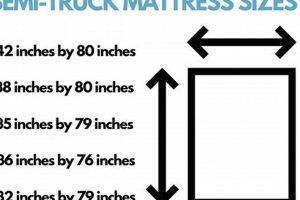
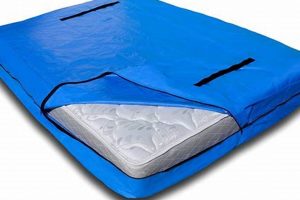
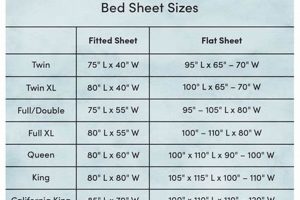
![Best Hybrid Queen Mattress [Year]: Comfort & Support Organic & Natural Mattress Buyer’s Guide: Non-Toxic Sleep Solutions Best Hybrid Queen Mattress [Year]: Comfort & Support | Organic & Natural Mattress Buyer’s Guide: Non-Toxic Sleep Solutions](https://mattressworldpa.com/wp-content/uploads/2025/07/th-2259-300x200.jpg)
